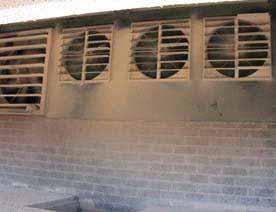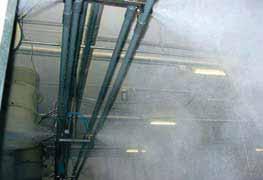
3 minute read
Dust

Dust
Advertisement
There’s no such thing as a dust-free poultry house. Litter, manure, feed and feathers all turn into dust eventually. Dust is bad for the health of humans and hens. Dust particles get into the lungs. In combination with ammonia, which affects the mucous membranes, this increases the risk of infection in the birds. Breathing in dust is also dangerous to human health, particularly: in high concentrations when you stay in the house for a long time with very fine particles.
What starts out as a seemingly harmless symptom like a tickle at the back of your throat, sneezing and coughing can turn into serious illnesses like bronchitis, shortness of breath, asthma or reduced lung capacity. Never underestimate the health risks of dust; it is best to wear a dust mask.
Types of dust
The smaller the dust particles, the deeper they penetrate into the lungs and the more harmful they are. They are classified as follows: Inhalable dust: particles of less than 50-100 μm.
You can inhale these particles, but you can also expel them via the cilia in the lungs. Thoracic dust or particulate: particles of less than 10 μm. Respirable dust: particles less than 4 μm.
These are very small particles that come to rest in the alveoli and damage the lung function.
Dirt and dust in inlet valves and ventilation ducts cause more resistance. This reduces the ventilation capacity, so the temperature rises. The electricity consumption will rise unnecessarily.copyright protected

Keeping the aisles in a house with cages clean helps to cut down on dust. Cleaning weekly prevents large amounts of dust from settling which can be disturbed again. Tip: Use a clean filter. An ineffective or old filter will cause the vacuum cleaner to re-expel some of the dust particles. So clean and replace the filter regularly. And don’t forget to wear a dust mask yourself. A lot of dust is released during vaccination. When doing these kinds of tasks, always wear a dust mask. Correct use of a dust mask reduces the risk of inhaling dust by 90%. Masks with an exhalation valve are more comfortable to wear. Use P2 masks as a very minimum.
Solutions for the future
1. Applying an oil film in floor housing systems: binding dust particles by applying a film of rapeseed oil or sunflower oil over the litter.
This reduces the amount of dust by 50-90%.
Downside: dirt becomes caked.
2. Water spray: settle dust by spraying with clean water. This reduces the amount of dust by 80% (coarse dust) and 50% (fine dust). Downside: relative humidity in the house can become too high, so the litter can get too wet.
3. Air recirculation with cleaning: outgoing air can be recirculated after cleaning (e.g. filtration, air washing). This reduces the amount of dust by 40-60%.
4. Ionisation: settle the dust by charging the dust particles by applying a voltage difference. The charged particles will then stick to earthed surfaces like the floor and walls. This reduces the amount of dust by about 35%.
These techniques have an additional environmental benefit: much less dust is emitted into the open air. Spraying the litter with oil.

Activities and their dust scores Dust score 12 12 12 12 6 3

The dust burden in the house varies depending on the activity. The dust score ranges from 1 to 18, with 18 indicating a very high dust burden and 1 a very low one. These figures do not represent the absolute quantities of dust but a combination of quantity and time. For example, removing hens generates a lot of dust but only for a short period; floor eggs generate very little dust but over a longer period. So There is a voltage difference along the wire with protrusions (ionisation). Presence between hens Delivery of layers Removing birds (catching and loading) Handling individual birds (healthcare etc.) Collecting floor eggs in aviary and floor systems Treating groups of hens (group vaccination) Inspections among birdscopyright protected the total dust burden of these two activities Other activities in the house is the same.
Cleaning the house Removing dust from aisles, dry Removing dust from aisles, wet Scattering straw and litter Mucking out chicken house with shovel/loader Collecting eggs and inspecting in lobby Inspecting from feed aisle during feeding in cage systems Inspecting from feed aisle outside feeding times in cage systems

www.pakstofaan.nl










